KELOWNA ANNUAL HOUSING REPORT
 PREPARED BY POLICY & PLANNING DEPARTMENT - APRIL 2022
PREPARED BY POLICY & PLANNING DEPARTMENT - APRIL 2022

 PREPARED BY POLICY & PLANNING DEPARTMENT - APRIL 2022
PREPARED BY POLICY & PLANNING DEPARTMENT - APRIL 2022
The Annual Housing Report explores Kelowna’s housing system based on the City’s Housing Wheelhouse, which was updated in 2021 (see page 4). Kelowna is a desirable place to live, and in 2021 the City had high population growth and a relatively low unemployment rate. These factors, along with historically low interest rates, contributed to increased demand for housing in 2021, with prices for ownership housing in particular rising significantly compared to 2020.

Over the course of 2021, there were several positive developments related to housing in Kelowna including:
• Council’s endorsement of the Complex Needs Advocacy Paper to advocate for additional complex needs housing
• The City’s ongoing work with the Central Okanagan Journey Home Society on a Data Roadmap to improve access to data on homelessness and emergency shelter housing
• The issuance of a record number of residential building permits, about 80 per cent of which are for multi-family housing, which is more attainable than single dwelling housing
• An increase in the number of new supportive housingi units compared to 2020 (183 units vs. 158 units)
• An additional 440 units of subsidized rental housing in the development application process
• An increase in the number of new purpose-built market rental units, with 3,296 additional units in the development application process
i Supportive housing is stable housing with supports that may be short- or longterm and is typically offered by non-profit and other housing providers.
That said, Kelowna is facing ongoing challenges related to housing including:
• The number of people experiencing homelessness appears to be increasing despite additional units coming online
• A low primary market vacancy rate of 0.6 per cent and rising rental rates
• Kelowna’s median multiple, a measure of unaffordability, hit a 10 year high meaning it became even more challenging to purchase a home in 2021
The City, in collaboration with our partners, is taking many actions to address housing affordability and encourage additional housing supply across the Wheelhouse. We continue to support the Journey Home Strategy and provide incentives for supportive housing, subsidized rental housing, and market rental housing. The City also contributes land for subsidized rental housing through the Affordable Housing Land Acquisition Strategy and encourages diverse housing options through initiatives such as the 2040 Official Community Plan and the Infill Challenge 2.0. See Appendix A for a summary of housing projects that the City has partnered on.
Each year, the Annual Housing Report provides key data and insights about Kelowna’s housing system. Like the 2020 Annual Housing Report, the 2021 report is structured around the City’s Housing Wheelhouse (see page 4). Using the Housing Wheelhouse as a reporting tool helps link the Annual Housing Report to other City documents related to housing, including the Housing Needs Assessment and the Healthy Housing Strategy For each segment of the Wheelhouse, we provide a review of recent data, comment on City actions, and explore relationships to other parts of the Wheelhouse.
Population and economic trends help to provide an understanding of what’s happening in the housing system. When the population and economy grow, like we’re seeing in Kelowna, the demand for housing typically increases too. Monetary policy, especially interest rates, also plays a role in demand for housing, as outlined below.
From 2016-2021, the City’s population grew rapidly, increasing by 14 per cent, and the Kelowna Census Metropolitan Area was the fastest growing region in Canadai. Population growth accelerated further in 2021, with a net population increase of over 5,000 people. The largest migration group in 2021 was interprovincial migration – people moving to Kelowna from within Canada but outside of British Columbia (Figure 1). These figures show that Kelowna continues to offer an attractive environment in which to live and work.
i Statistics Canada. 2022. Canada tops G7 growth despite COVID. https:// www150.statcan.gc.ca/n1/daily-quotidien/220209/dq220209a-eng.htm
Although COVID-19 continues to impact our day-to-day lives, Kelowna’s unemployment rate is much lower than it was at the peak of the pandemic (Figure 2). The unemployment rate and the number of people employed has remained stable over the course of 2021, indicating that the economy has stabilized following the most intense COVID-19 impacts. Additionally, Kelowna’s unemployment rate remains lower than many other Census Metropolitan Areas in BC.
Notably, 2021 saw the highest number of residential building permits ever issued in Kelowna, demonstrating a high level of developer confidence in Kelowna’s housing market and a strong post-pandemic recovery of the development and construction industries.
Monetary policy, including interest rates, impacts the housing system. High interest rates mean that it is more expensive to take out a mortgage; therefore, higher interest rates tend to lower the demand for housing. Low interest rates, in contrast, mean that it is more affordable to borrow more money for a mortgage, and tend to correlate with increased demand for housing. In recent years, we’ve seen record low interest rates in Canada, making real estate a more viable and attractive option for both buyers and investors. The Bank of Canada interest rate currently remains low but was increased in early 2022 and is forecasted to increase further in response to high levels of inflation seen in 2021 – reduced interest rates may also reduce demand for housingii ii Global News. (2022). https://globalnews.ca/news/8654004/canada-interest-rate-hike-march-2022/
The City of Kelowna completed a Housing Needs Assessment in 2017, and through that process established the housing Wheelhouse (Figure 3). The Wheelhouse shows the variety of housing needed for a healthy community housing system. Additionally, the Wheelhouse promotes equity and inclusion by recognizing that people may move from segment to segment of the Wheelhouse throughout their lives. The Annual Housing Report uses the Wheelhouse as a framework to assess and report on housing.
The City’s Housing Wheelhouse was updated in 2021 to better reflect Kelowna’s current housing system (Figure 3). The key change was that “short-term supportive housing” and “longterm supportive housing” were combined into a general “supportive housing” category. This update is to acknowledge that supportive housing cannot necessarily be neatly divided into short-term and long-term housing. Rather, supportive housing is a complex category that provides a variety of supports and services to many different populations over various time frames.
The Housing Wheelhouse has three broad housing categories:
• Safety net housing: non-profit organizations provide housing and other services to those experiencing a lack of housing or inadequate housing. This includes supportive housing for people who are transitioning out of or are at risk for homelessness.
• Housing with supports: non-profit and other housing providers offer stable housing that may be short- or long-term. Supports and services are aligned with residents’ needs and may include physical, cognitive, and financial supports. The level of support varies, ranging from low support, such as rental assistance, to moderate support, such as assisted living, to full support, such as residential care.
• Market housing: most of the housing in Kelowna falls under the category of market housing. Market housing is privately owned and does not include any forms of support, financial or otherwise.
These broad categories are further divided into five segments: emergency shelter, supportive housing, subsidized rental, market rental, and ownership. Each segment is reported on below.
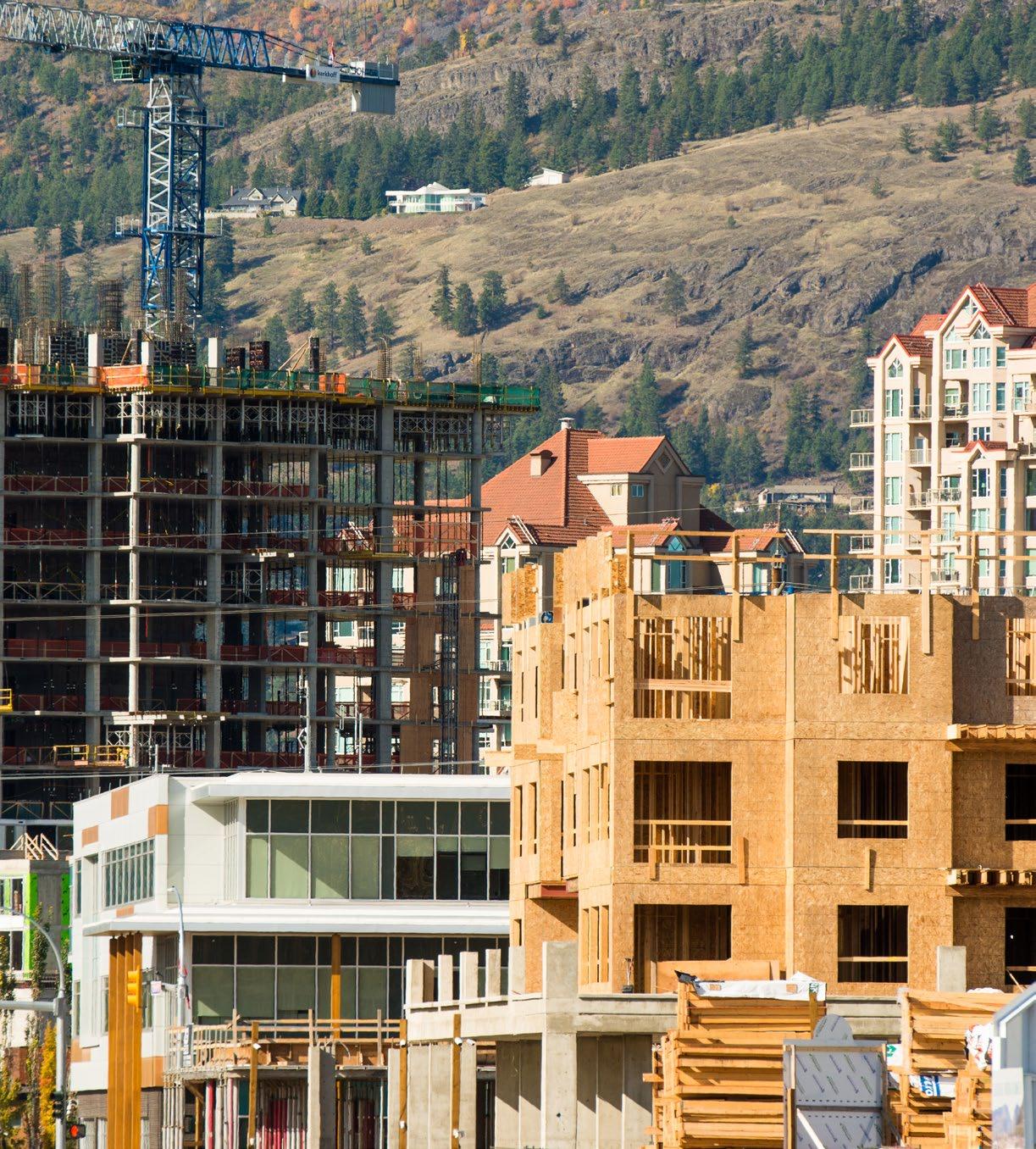
Emergency shelters offer temporary shelter and other supportive services – including food, clothing, connections to healthcare and community services – for people experiencing a lack of housing or inadequate housing.
Point-in-time counts provide a snapshot of homelessness in our community. While point-in-time counts provide a way to measure progress, they are generally considered an undercount. The most recent point-in-time count on the number of people experiencing homelessness in Kelowna was completed by the Central Okanagan Foundation on March 10, 2020i. At least 297 people were found to be experiencing homelessness, a 4 per cent increase from 2018. The point-in-time count found that emergency shelters had capacity for approximately 240 people, and therefore would not have had enough capacity to accommodate all people experiencing homelessness.
As point-in-time counts are only conducted every two years, there is no quantitative update available for 2021. Over the past two years, fluctuating COVID-19 protocols impacted, and at times reduced, the number of emergency shelter beds available, resulting in more people sheltering outside. Late in 2021, local shelters took innovative approaches to bring their capacities up to pre-pandemic levels. BC Housing also funded three additional temporary shelters in Kelowna, for a total of approximately 280 beds in 2021. However, despite the significant number of people that have been housed, the number of people experiencing unsheltered homelessness appears to be increasing.
The Journey Home Strategy is Kelowna’s plan to address homelessness and is supported by the City. The strategy provides a roadmap for improving systems and practices to support housing for people who are transitioning out of or are at risk of homelessness. The Central Okanagan Journey Home Society (COJHS) was established to implement the Journey Home Strategy, and through a Memorandum of Understanding with the City is working towards the goal of achieving a functional end to homelessness in Kelowna.
The City invests in and supports the Journey Home Strategy, particularly in the areas of systems planning, capacity building, advocacy, and data integration. For example, the City is currently working with COJHS to finalize a Community Emergency Shelter plan and Shelter Location Criteria. These planning documents will help to clearly articulate Kelowna’s vision for emergency shelter housing and allow for advocacy to the provincial government for investment in emergency shelter services. Additionally, the City works to build relationships with other organizations on the topic of homelessness and supports advocacy projects such as an anti-stigma campaign.
Getting better data about emergency shelter housing is also a priority for the City. See the Project Spotlight box below for more information about how the City is working in partnership with COJHS on this topic.

Costs for both rental and ownership housing have been rising consistently in Kelowna, and 2021 was no exception. For those at risk of homelessness – people without access to social and financial supports – increasing housing costs may result in homelessness. Providing adequate, affordable housing with the right supports is critical to reducing the demand for emergency shelter services in Kelowna.
Data on homelessness and emergency shelters currently spans multiple ministries and agencies – accessing this data is an ongoing challenge. Because there is currently no mechanism to collect and integrate comprehensive, system-wide, real-time data about individuals experiencing homelessness, we don’t have a clear understanding of the level of need or our progress.
The City has been working with COJHS since 2020 to address the lack of integrated data, starting with a Data Integration Requirements Exercise which informed a Data Roadmap. The Roadmap is designed to support the establishment of one comprehensive, real-time, person-specific list of everyone currently experiencing homelessness in our community. This single source of data will provide an accurate understanding of individuals who are experiencing homelessness, how to find them, and what their housing and support needs are. Integrated data is a critical component for developing local solutions to homelessness and will also help the City of Kelowna better advocate to senior levels of government.
Supportive housing is stable housing with supports that may be short- or long-term and is typically offered by non-profit and other housing providers. Supports and services are aligned with residents’ needs and may include physical, cognitive, and financial supports. The level of support varies, ranging from lower support, such as assisted living, to full support, such as residential care.
Supportive housing has two broad streams: housing for people transitioning out of or at risk of homelessness who need supports, and housing for seniors who need supports. These two types of housing both provide supports for residents, but they are generally developed, funded, and operated by two different systems.
Demand for supportive housing is difficult to quantify with the data currently available; however, demand appears to be increasing. We know that there is urgent and significant need in Kelowna for housing for people that experience complex and overlapping health conditionsii. Additionally, the median age is Kelowna is rising, meaning the need for supportive housing for seniors is likely to increase over time.
In terms of supply, there was a slight increase in number of supportive housing units that became available in 2021 (183 new units) compared to 2020 (158 new units).
ii City of Kelowna. (2021). Complex Needs Advocacy Paper.
Most of the 183 supportive housing units that became available in 2021 were microsuite and bachelor units (Table 2, Figure 4). Approximately 25 per cent of the supportive housing units were oriented towards people who are transitioning out of homelessness and approximately 75 per cent were oriented towards seniors. There are currently no supportive housing projects the development approval process.
The City supports the development of supportive housing through collaboration with partner organizations (see Appendix A for examples). We also offer financial incentives, such as rental housing grants and tax exemptions for supportive housing. One specific area of supportive housing that the City is focusing on is known as complex needs housing. Complex needs housing is for people with overlapping health conditions such as substance use disorders, co-morbid developmental disabilities, acquired brain injuries, and fetal alcohol spectrum disorder. The pandemic has increased the demand for complex needs housing, with service providers noting deteriorating medical and mental health, as well as increased substance use in Kelowna.
Source: City of Kelowna.
The City has taken a leadership role in advocating for complex needs housing. In 2021, the Complex Needs Advocacy Paper was endorsed by Kelowna City Council. The advocacy paper provides a roadmap for how different organizations can work together to deliver an effective system of care and housing for people with complex needs.

Supportive housing helps to provide stable housing for people with a variety of complex and overlapping needs, such as financial, mental, physical, and social needs. As housing becomes less affordable, individuals that are ready to leave supportive housing to live independently may find it increasingly difficult to do so. As a result, waitlists for supportive housing may grow and people seeking supportive housing may become “stuck” in the emergency response system. This creates increased pressure on emergency shelters and contributes to in people living in inadequate housing conditions.
adults who were formerly homeless or at risk of homelessness and who need supports.
On-site supports are tailored to residents’ needs and may include wellness checks, life skills training, employment assistance, and referral to community servicesi. One floor of the project is dedicated to supporting young adults, a first for Kelowna. Staff are available to residents 24-hours a day through an expanded care model.
i BC Housing. letstalkhousingbc.ca.
Subsidized rental housing, also called affordable rental housing, is generally operated by non-profit housing providers. In this segment of the Wheelhouse, rent is subsidized through monthly subsidies or capital grants. Subsidized rental units cost approximately 65-80 per cent of market ratesiii
Rising rents indicate that demand for subsidized rental housing is increasing in Kelowna. While there is no centralized waitlist for subsidized rental housing in Kelowna, the BC Housing waitlist – a waitlist for some of the affordable housing in Kelowna – provides an indication of demand. In 2021, there were approximately 300 individuals on the BC Housing waitlist in Kelowna. About half of the people waiting for subsidized rental housing are seniors. Of the 88 new subsidized rental units that were occupied in 2021, most were 1- and 2-bedroom units (Table 3, Figure 5). There was also an increase in new bachelor units and a decrease in new 3-bedroom units in 2021 compared to 2020.
iii Based on estimate provided by the Society of Hope.
Approximately 440 additional units of subsidized rental housing are in the development approval process in Kelowna and are anticipated to be built over the coming years (Table 4, Figures 6-7). At the time of reporting, subsidized rental housing projects make up 10 – 15 per cent of all the proposed rental housing in Kelowna, with the remaining 85 – 90 per cent being market rental units.
The City is seeking to increase and optimize land acquisition for affordable housing through the Affordable Housing Land Acquisition Strategy. The City also continues to track new subsidized and market rental projects through the Rental Housing Inventory Additionally, we provide ongoing incentives for subsidized rental housing grants and tax exemptions. Between incentives and grants, the City provided over $500,000 in financial support to two subsidized rental projects in 2021 which together have over
Renters are proportionally more likely than homeowners to spend more of their income on housing costs. The most recent data available indicates that approximately 47 per cent of Kelowna renters spend over 30 per cent of their income on housing, meaning their housing costs are considered unaffordable. Coupled with 2021’s rising rents and stagnant wages, affordability has not improved over the past year. Without a healthy supply of subsidized rental units, those earning low to moderate incomes will struggle to find housing they can afford. Subsidized rental housing a critical alternative to market housing that helps to ensure that people who can’t afford market housing do not have to rely on emergency shelter housing or face homelessness.
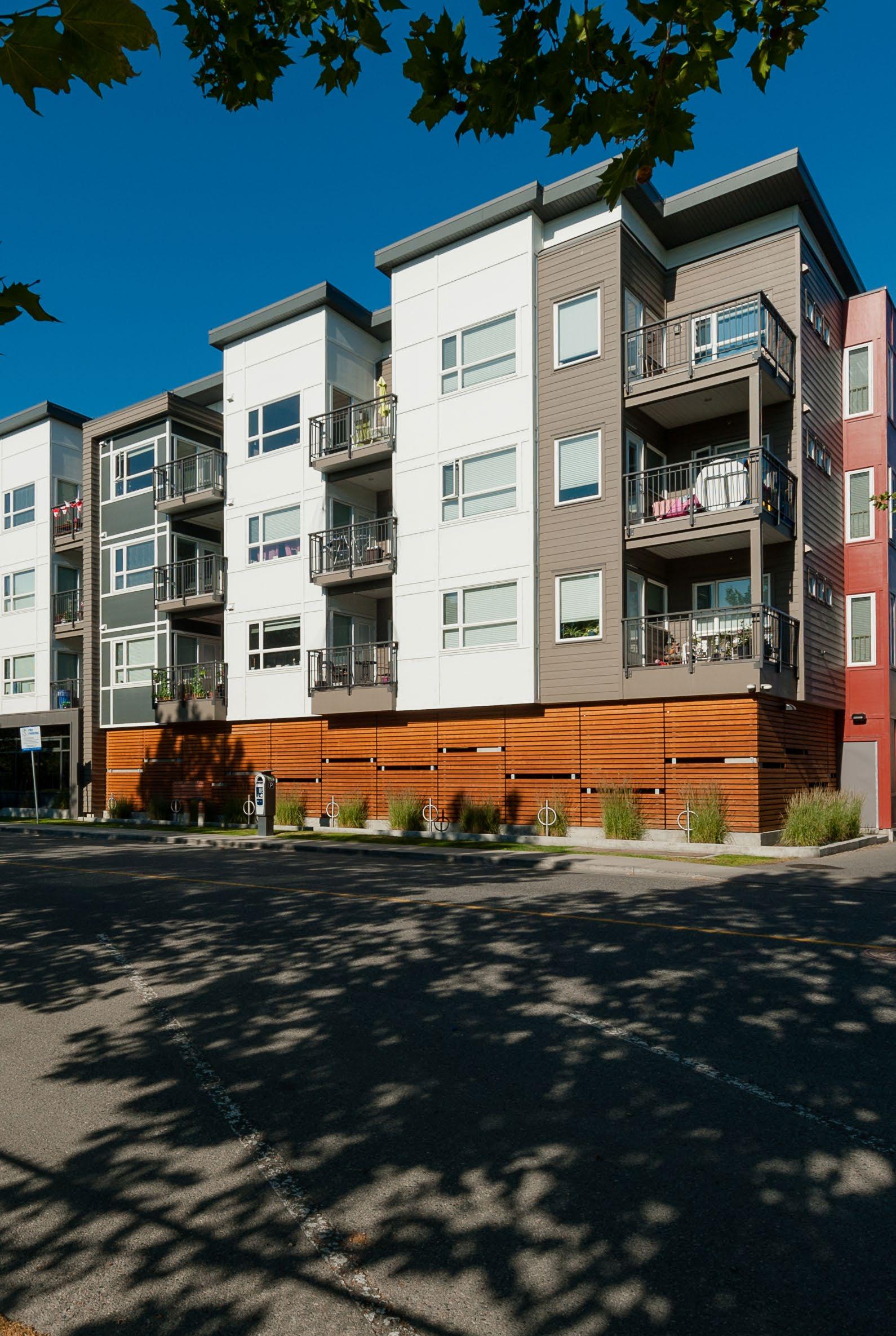
In 2021, 40 new affordable rental homes became available at 1060 Cawston Avenue. These units were built to serve Kelowna residents with low to moderate incomes in Kelowna – especially women, single-parent families, and seniorsi. The four-storey building has a mix of studio, one-, two-, and three-bedroom homes with monthly rents ranging from $375 to approximately $1,835, depending on the size of the unit and tenant income.
The project boasts solar panels on the roof, improving sustainability and lowering tenants’ energy costs. Additionally, the location of the project is close to amenities such as schools, shopping, transit, and other day-to-day services. This project was made possible by collaboration between the NOW Canada Society, the City, and significant financial contributions from senior levels of government.

Market rental housing refers to both primary and secondary rental market housing. Primary rental housing generally consists of five or more units that are constructed as purpose-built rental housing. The secondary rental market includes many forms of private rental housing such as secondary suites, carriage homes, privately owned apartments, and single detached homes.
In the primary rental housing market, there were 716 new purpose-built rental units occupied in 2021. In 2020 and 2021 combined, over 1300 new purpose-built rental units were occupied, representing a significant increase in the amount of purpose-built rental units in Kelowna. In 2021, 1- and 2-bedroom units were the most common, and there was also an increase in new microsuite units and 3-bedroom units compared to 2020 (Figure 8).
Investment in purpose-built market rental housing is anticipated to continue in Kelowna over the coming years (Table 5, Figures 9-10). About half of the in-stream units are 1-bedroom units, followed by 2-bedroom units.
While the number of purpose-built rental units is increasing yearover-year in Kelowna – particularly since 2017 – the City’s vacancy rate remains low. Between three and five per cent is considered a healthy vacancy rate; however, in 2021 Kelowna’s vacancy rate dipped to 0.6 per cent, the lowest since 2017 (Figure 11)i. The vacancy rate for bachelor units decreased from 6.4 per cent in 2020 to 0.1 per cent in 2021 – this is likely an outcome of students returning to in-person education and needing rental accommodation. Vacancy rates for 1- and 2-bedroom units also dropped to below 1 per cent in 2021. The 2021 vacancy rate for 3+ bedroom units remained similar to 2020 at 1.4 per cent. Overall, low vacancy rates indicate that there is more demand for rental units than is currently available.
Rental rates also rose in Kelowna from 2020 to 2021 (Figure 12). As per the Canada Mortgage and Housing Corporation, Kelowna’s overall rental rate increased 4.8 per cent from $1,255 in 2020 to $1,315 in 2021ii. CMHC provides the overall average of rent paid, which is lower than rental rates of currently available units. Rental rate changes were not distributed equally among different unit types: bachelor units decreased by 2 per cent, one-bedroom units increased by 4 per cent, 2-bedroom units increased by 6 per cent, and 3-bedroom units increased by 7 per cent.
In terms of the secondary rental market, advertised rental rates for secondary rental units were higher than primary rental units with the median 1-bedroom rate at $1,700, 2-bed room at $2,600, and 3-bedroom at $2,900iii. Furthermore, data from KNEW Realty Research indicates that new purpose-built rental units are renting for lower rates than existing secondary market rental units (Figure 13). Additionally in 2021, 169 occupancy permits and a further 343 building permits were issued for secondary suites and carriage houses in Kelowna.
Overall, low vacancy rates, high rents, and a growing population reinforce the importance of ongoing investment in purpose-built rental housing. The City provides significant support for purpose-built rental housing through the rental housing tax exemption program. The total estimated future tax exemption for all rental units from 2022 to 2031 is approximately $16.5 million, accounting for about 2,600 rental housing units across 30 buildingsiv. In 2021 specifically, the City provided tax exemption support to over 300 units of purpose-built rental housing. The Zoning Bylaw also has rental incentives in the form of parking reductions for developers who commit to rental only zoning.
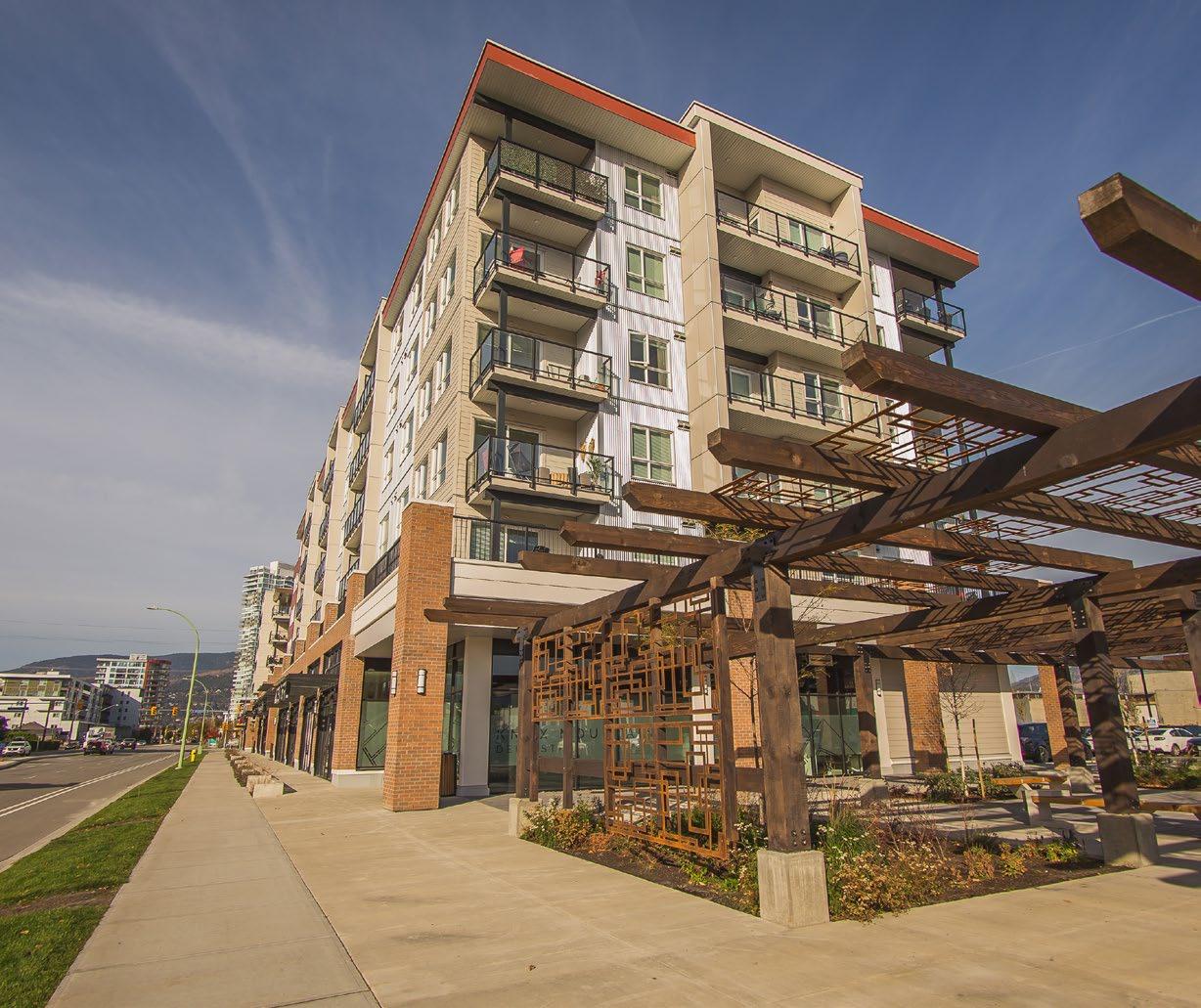
While Kelowna has brought on a record number of rental units in recent years, there is still unmet demand for rental housing due to strong population growth and decreasing vacancy rates. Additionally, rising home ownership costs are expected to further increase demand for rental housing. If rental rates continue to rise and the gap between market rental rates and subsidized rental rates becomes too large, it will become more difficult for people to move from subsidized rental housing into market rental housing or home ownership. Overall, an adequate supply of market rental housing that aligns with local incomes is critical to provide relief from expensive home ownership and to reduce pressure on subsidized rental housing.
Ownership Housing refers to privately owned homes and housing units. Ownership housing comes in different forms, including apartments, townhomes, and single-detached homes (SDH).
Kelowna is a highly desirable place to purchase a home. Despite the COVID-19 pandemic, 2020 and 2021 saw above an average number of home sales and a large increase in median home prices. In 2021 specifically, there were 5,314 homes sold in Kelowna, which is higher than the 10-year average of 3,517i. There was also a 3.3 per cent increase in new listings in the Central Okanagan (10,562 listings in 2021 compared to 10,229 listings in 2020) –this is still slightly below pre-pandemic levelsii. Sales activity was strongest in the spring and early summer.
Home prices continued to rise in 2021, and the overall median home price rose significantly from $543,000 in 2020 to $650,000iii in 2021 (Figure 14). The median SDH price increased 21.4 per cent from $735,000 in 2020 to $892,000 in 2021 and the median townhouse price increased 15.8 per cent from $501,000 in 2020 to $579,950 in 2021. Strata units also saw a large increase of 11.2 per cent from $364,300 in 2020 to 405,000 in 2021.
Regarding the type of housing being purchased, SDH trended downwards in terms of proportion of home sales compared to 2020. Strata units, in comparison, trended upwards (Figure 15).
Regarding new construction, most of the housing units that became available in 2021 were apartment units (64 per cent), followed by SDHs (19 per cent) and townhouse and houseplex units (17 per cent) (figure 16).
The City recognizes the growing unaffordability of single detached homes and supports increased diversity in home ownership forms throughout key policy documents. Kelowna’s 2040 Official Community Plan was finalized in 2021, and it promotes increased residential density in Urban Centres, more housing variety, and increased housing attainability. Additionally, the City encourages infill housing in existing neighbourhoods through initiatives like RU7 zoning and the Infill Challenge 2.0.
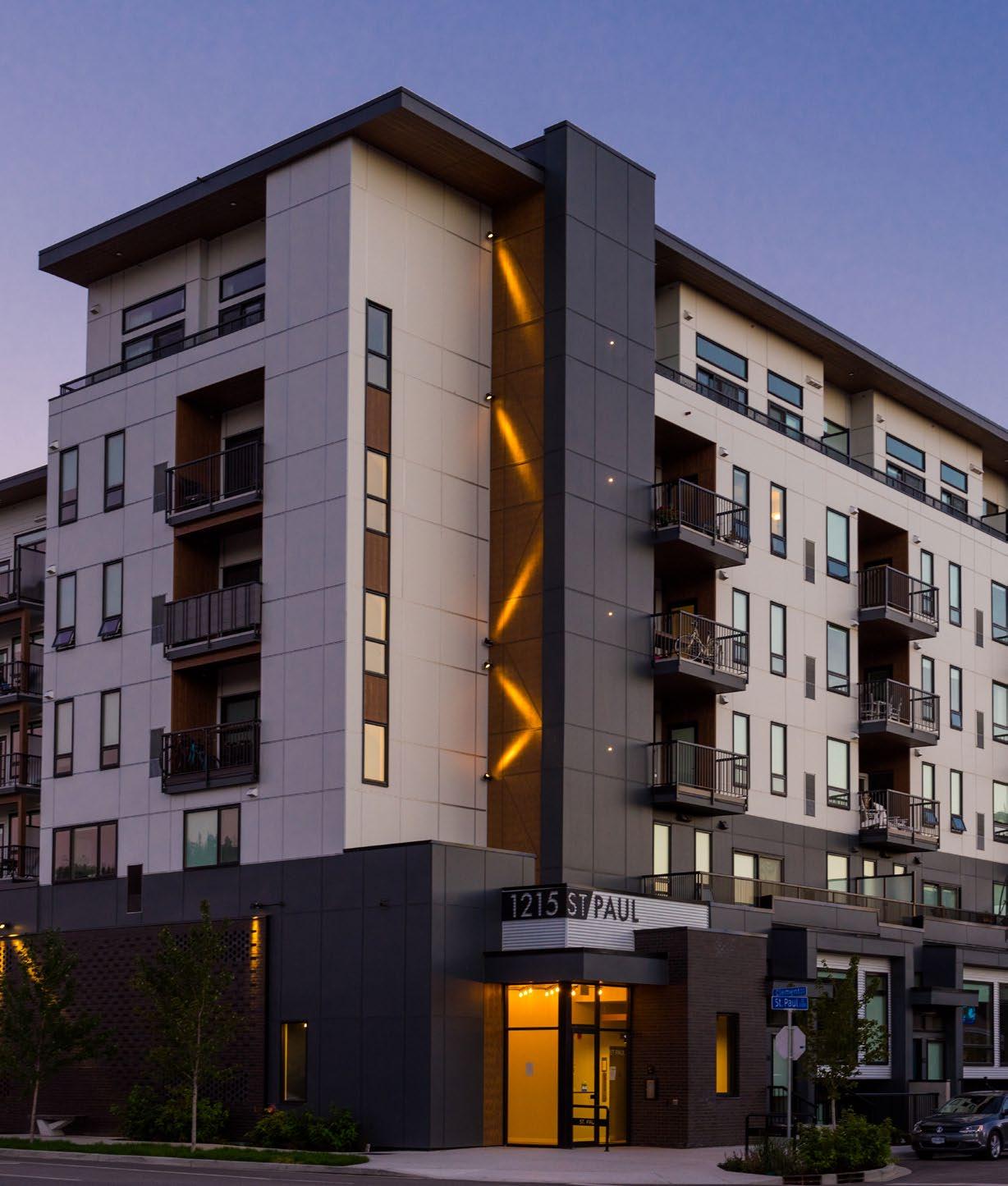
Overall, home ownership affordability decreased in 2021 for all housing types, and especially for SDH. Affordability can be measured with the median multiple, as shown in Figure 17. The median multiple shows the ratio of median house price to median household income. In Kelowna, the median multiple has been well above the target of 3.5 over the last 10 plus years, and reached new levels of unaffordability in 2021 with a median multiple of 8.73.
Building the right mix of housing, including a focus on apartments and missing middle housing forms like townhomes, is one way to help ensure that there are more attainable options for Kelowna residents. If home prices continue to rise without corresponding wages increases, fewer people will be able to purchase homes, and it is likely that other segments of the Wheelhouse will see more demand, particularly market rental housing.
Kelowna is a desirable city that’s experiencing strong population growth. Kelowna’s economy is also growing, and has fared better than other comparable areas when it comes to COVID-19 recovery. In combination with historically low interest rates, these factors mean that the City is facing a high demand for housing, and housing affordability and attainability remain key concerns.
The City, in collaboration with our partners, is taking actions to support housing across the Wheelhouse (Figure 18). We’re also working to increase and expedite housing supply by reviewing and updating processes including: implementing items from the provincial Development Approval Process Review report, waiving public hearings for development proposals that are compliant with the Official Community Plan, and adopting zoning bylaw changes to allow supportive housing, emergency shelters, secondary suites, and carriage houses in more areas of the City. Many of our initiatives are yielding results: in 2021, a record number of residential building permits were issued, about 80 per cent of which are for multi-family housing, which will increase the housing supply over the coming years (Figure 19).
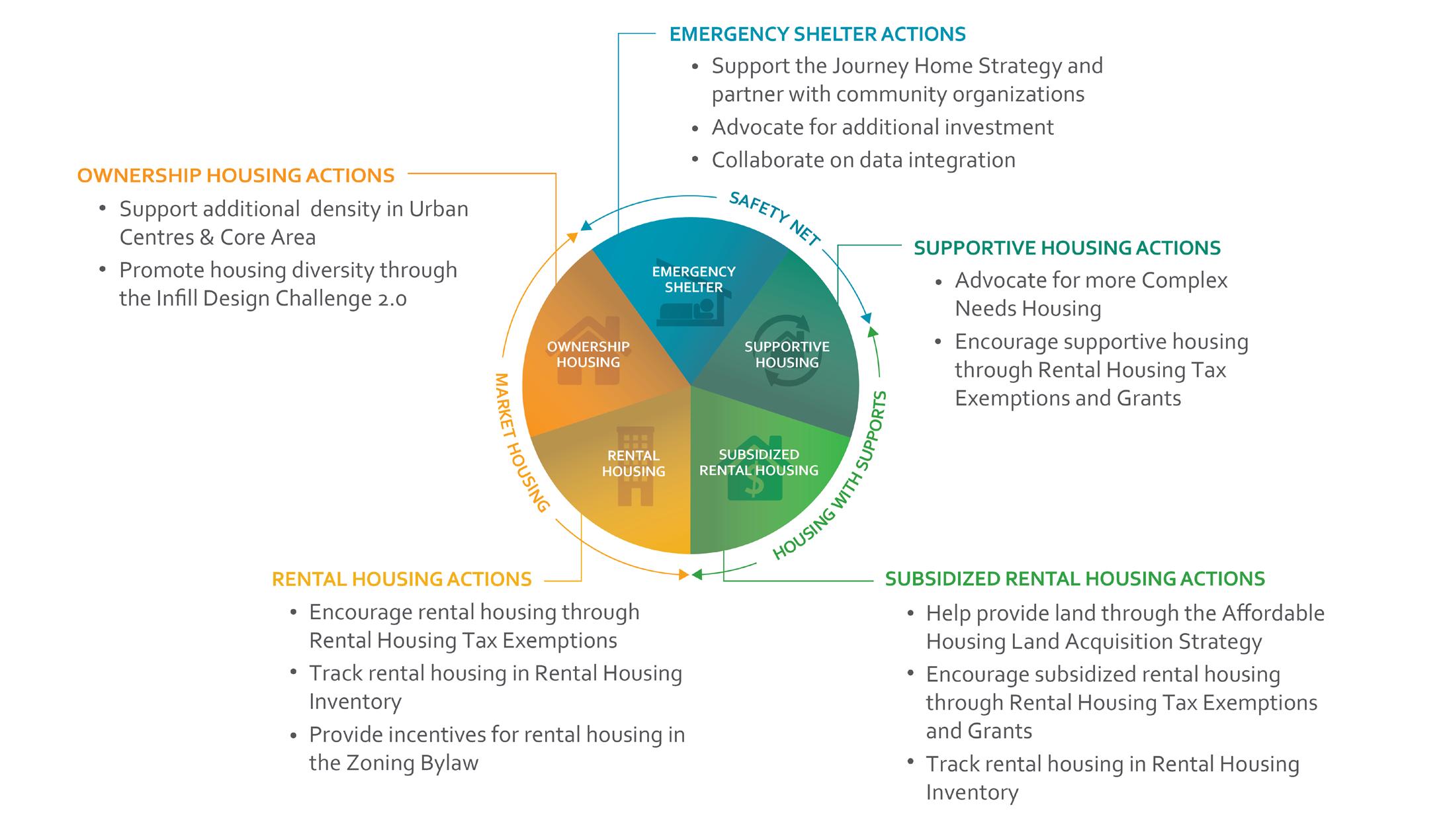
Despite ongoing effort to support housing supply, the growth – and associated housing demand – that Kelowna is experiencing is beyond what we have seen in past years. There are many factors that contribute to housing demand that cannot be controlled locally. Spikes in population are particularly difficult for the housing system to respond to in real time as developing significant amounts of housing, especially in the form of large projects, can take years to accomplish. Forecasted
interest rate increases may temper some of the demand for housing; however, if population growth continues to rise at the pace seen in 2021, high housing demand will likely persist. While challenges in the housing system are beyond the scope of the City to solve singlehandedly, we have a significant role to play in shaping our community’s housing system. There is no one solution that will solve all the challenges that we are collectively facing related to housing, but rather a suite of tools – such as policies, regulations, and planning initiatives – that can be used to help support housing across the Wheelhouse today and into the years and decades to come.
The City of Kelowna and BC Housing are committed to collaborating together on Kelowna-based BC Housing initiatives. The City’s role ranges, and includes activities such as facilitating conversations between community partners, helping to identify housing opportunities, guiding site location, and providing long term leases on municipal land to BC Housing.